.
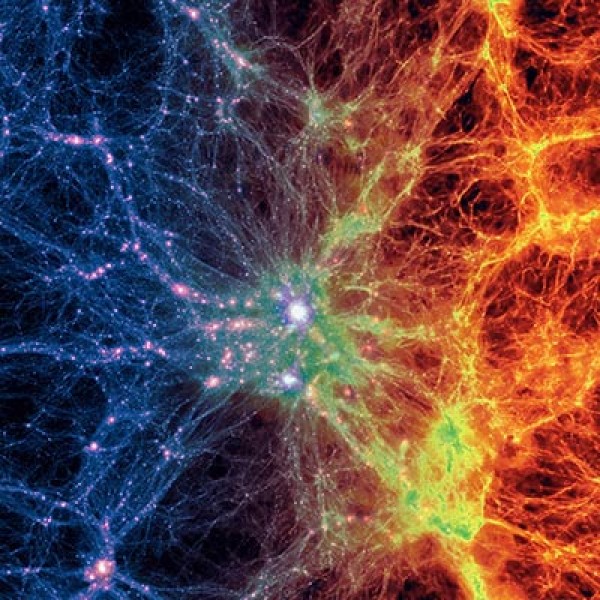
Supermodel. The new Illustris simulation (screenshot above; video below) tracks the intertwined evolution of the distribution of dark matter (left) and ordinary matter (right) through cosmic time.



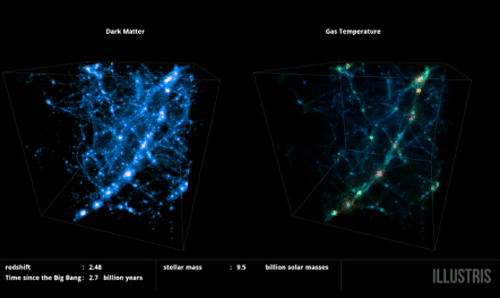
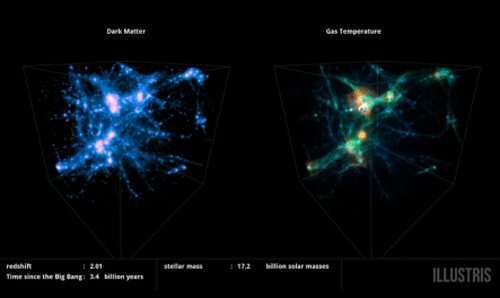
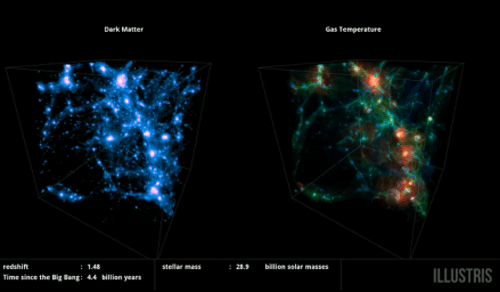


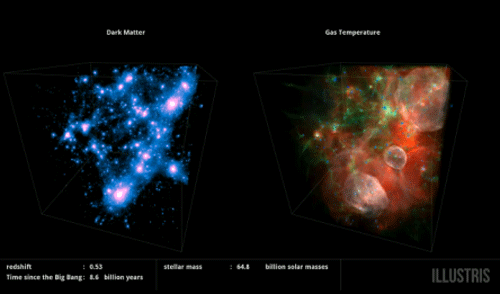




In the most detailed effort yet, astrophysicists and cosmologists have modeled the evolution of the universe right down to the formation of individual galaxies. The results of the mammoth computer simulation neatly match multiple astronomical observations, ranging from the distribution of galaxies in massive galaxy clusters to the amounts of neutral hydrogen gas in galaxies large and small. The findings once again neatly confirm cosmologists' standard theory of the basic ingredients of the universe and how it evolved—a result that may disappoint researchers hoping for new puzzles to solve.
"This is a tremendous advance," says Carlos Frenk, a cosmologist at Durham University in the United Kingdom, who works on a competing effort. "It changes the way we can address the physics at play in nature because we have a tool to handle the details." However, one leading researcher argues that the new work is not all it's cracked up to be.
For just over a decade, cosmologists and astrophysicists have known the precise recipe for the universe. From studies of the afterglow of the big bang or cosmic microwave background, the distribution of the galaxies, and other observations, they have determined that the universe consists of 5% ordinary matter like that in stars and people, 27% mysterious dark matter whose gravity holds the galaxies together, and 68% bizarre space-stretching dark energy, which is causing the expansion of the universe to accelerate.
Given that recipe, researchers have been able to simulate the evolution of the universe. In particular, in 2005 European researchers, including Frenk, developed the Millennium Simulation, which traced how over the age of the universe dark matter coalesced through its own gravity into gargantuan clumps and strands in a "cosmic web." Ordinary matter settled into the clumps to produce stars and galaxies. The Millennium Simulation matched statistically the size distribution of real galaxies and the way the galaxies are scattered throughout space. The results greatly bolstered the case for cosmologists' theory—which is known as ΛCDM (pronounced “lambda CDM”).
However, the Millennium Simulation was also limited, notes Mark Vogelsberger, an astrophysicist at the Massachusetts Institute of Technology in Cambridge. That’s because it actually tracked only the evolution of the dark matter web. Ordinary matter and galaxies were inserted into the web only at the end, using ad hoc rules taken from more detailed simulations of individual galaxies. Such an approach is known as semianalytic modeling. Now, Vogelsberger and colleagues have taken a step beyond that approach by developing a simulation that incorporates ordinary matter, in the form of hydrogen gas, from the start, as they report online today in Nature.
Known as Illustris, the new simulation tracks the evolution of a cubic chunk of the universe measuring roughly 350 million light-years on a side, which ends up containing 41,416 galaxies. The model is so demanding that it would take 2000 years to run on a single desktop computer. The difference between Illustris and its predecessor shines through in the animation Vogelsberger and colleagues made from the new simulation. Whereas Millennium shows only a relatively placid cosmic web, Illustris abounds with explosions: blasts of hot gas emanating from around the supermassive black holes in the hearts of galaxies. Such outflows are crucial to galaxy formation, as they can blow hydrogen gas out of a galaxy to slow or stop star formation.
To demonstrate that the new simulation reproduces the universe as we know it, Vogelsberger and colleagues show that it can reproduce a number of key observables, such as the abundances of elements heavier than helium in galaxies and intergalactic gas clouds. "The conclusion is that we think we have a pretty good understanding of galaxy formation and also that ΛCDM is basically correct," Vogelsberger says.
Illustris is the first simulation that's big enough to model a representative patch of the whole universe but detailed enough to track individual galaxies, says Simon White, a cosmologist at the Max Planck Institute for Astrophysics in Garching, Germany, who also worked on the Millennium Simulation. "It's the combination of those two things that is new," he says.
However, Joel Primack, a cosmologist at the University of California, Santa Cruz, argues that developers have oversold the new work. Although Illustris makes an important step by modeling gas on large scales, it still lacks the resolution to directly model, say, supermassive black holes themselves, he says. So it still uses semianalytic rules to account for such details, he says. "The people who are not in the field are reading the hype and being misled into thinking what they are doing is revolutionary and that people who aren't doing it are missing the boat," Primack says. "And that's just wrong."
Ultimately, the new simulation may be judged by its utility. It could be used to follow the evolution of particular types of objects through cosmic time, or to make predictions about what observers might see when they finally look back and count the earliest galaxies, Durham's Frenk says. It's where the simulation fails to match the data that it will be most fruitful, notes Marla Geha, an astrophysicist at Yale University. For example, Illustris seems to suggest that the stars in smaller galaxies form earlier than observations show. "There is something in star formation that isn't working in extreme conditions, so it can't be the whole story," she says. "That's intriguing to see."
Quelle: AAAS
6036 Views
